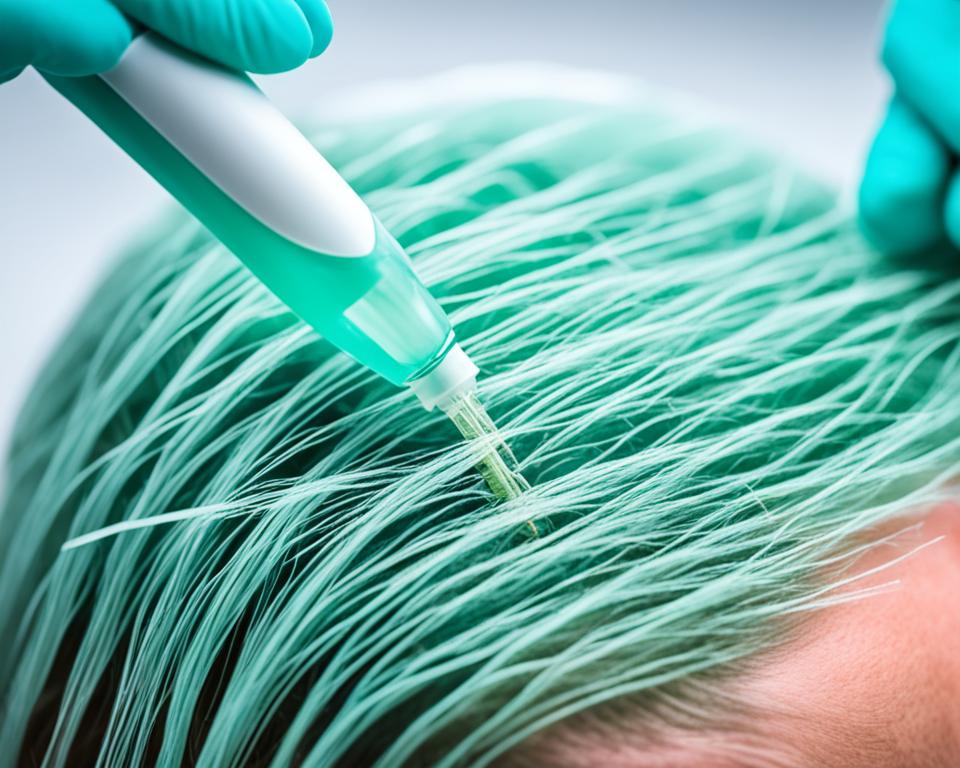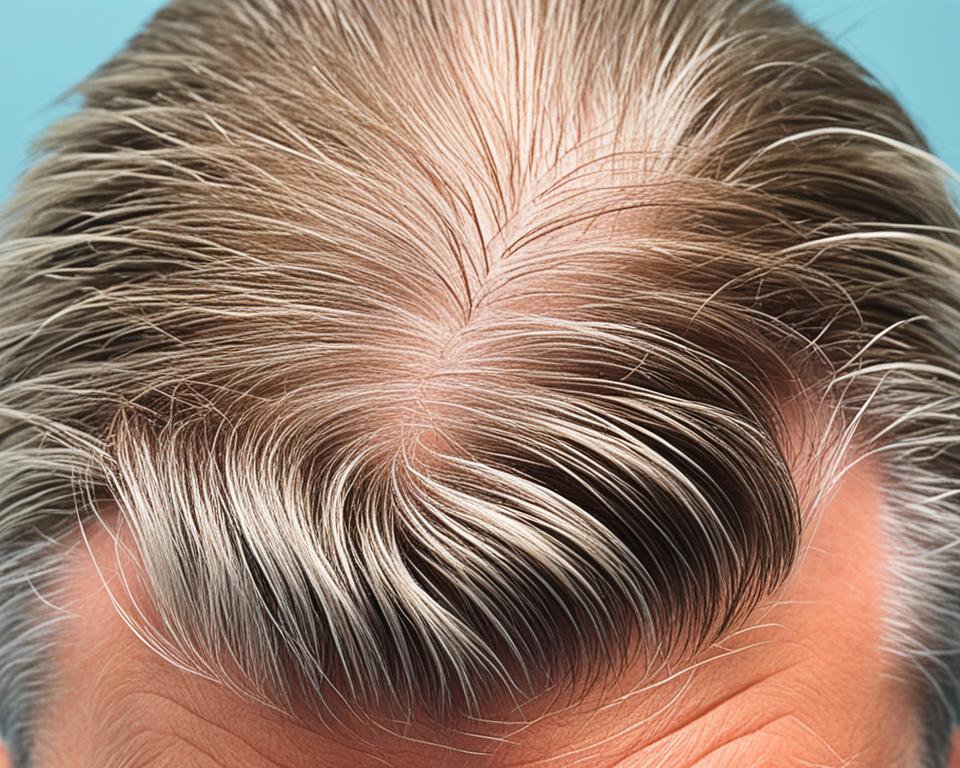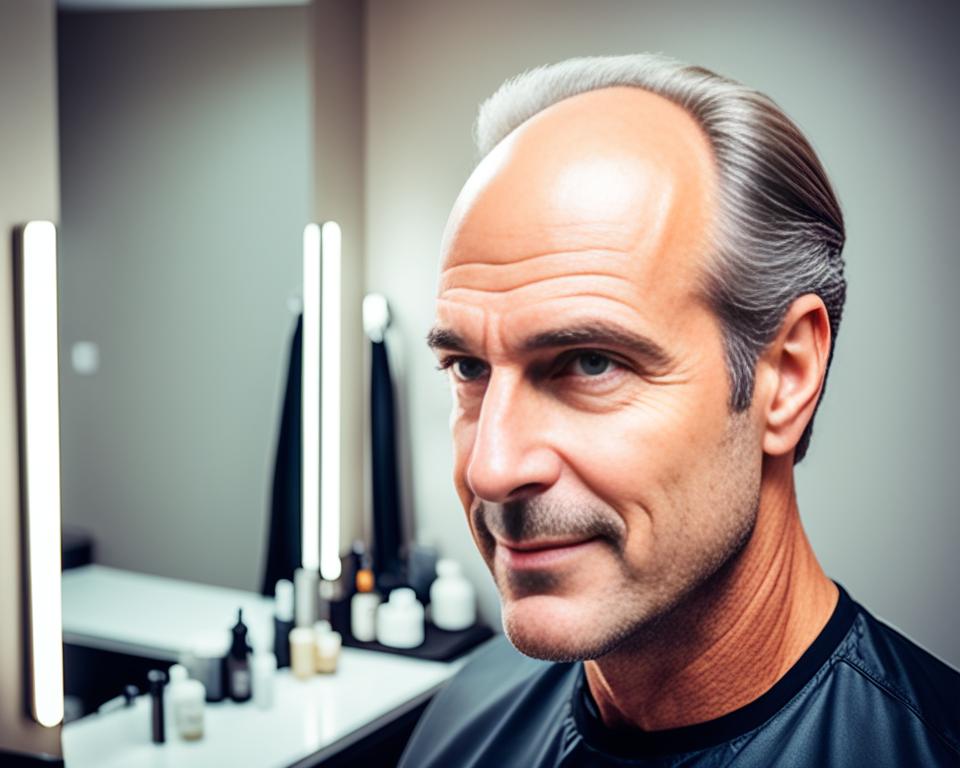FUT Hair Transplant: Restore Your Natural Hairline

Hair loss can be frustrating and make people feel self-conscious. Luckily, new surgical techniques offer a lasting solution. Follicular Unit Transplantation (FUT) is a popular method for fixing a receding hairline or thinning hair.
This method takes healthy hair follicles from the back and sides of your scalp. Then, it moves them to thinning or balding spots. This way, your own hair grows back naturally, giving you a natural look.
Read interesting things at : intarajyuku
Key Takeaways
- FUT hair transplant is a proven technique for restoring a natural-looking hairline and addressing hair loss.
- The procedure involves carefully extracting and implanting healthy hair follicles from the donor area to the recipient area.
- FUT offers a permanent solution for hair loss, with natural-looking and long-lasting results.
- Patients can expect a comprehensive guide on the FUT procedure, benefits, and recovery process.
- Comparison of FUT and FUE hair transplant methods to help readers make an informed decision.
What is FUT Hair Transplant?
Follicular Unit Transplantation (FUT), also known as strip harvesting, is a surgery to fix hair loss. It makes the hairline look natural and treats different types of hair loss treatment. Healthy hair follicles are taken from the back and sides of the scalp. Then, they are moved to the thinning or bald spots.
Understanding the Follicular Unit Extraction Procedure
In the follicular unit transplantation process, a surgeon takes a thin strip of skin with hair follicles. This area is closed with stitches, leaving a small scar that’s hidden by hair. The taken follicles are then carefully placed in the thinning spots, where they grow new hair.
Benefits of FUT Hair Transplantation
- Can move a lot of hair grafts in one session, usually 2,000 to 3,000 or more.
- Results look very natural, fitting well with the rest of the hair and hairline.
- It’s a safe and reliable method that works well over time to grow hair and improve scalp look.
- It’s a minimally invasive surgery with a good safety record.
The surgical hair transplantation method of FUT is a top choice for those wanting a lasting fix for hair loss treatment and a natural hairline.
Causes of Hair Loss Treatable with FUT
Hair loss is a common issue, with male pattern baldness and female pattern hair loss being top causes. Knowing what causes these conditions is key to finding solutions like Follicular Unit Extraction (FUT) hair transplantation.
Male Pattern Baldness
Male pattern baldness, also known as androgenetic alopecia, is the leading cause of hair loss in men. It’s a genetic condition caused by sensitivity to the hormone dihydrotestosterone (DHT). This sensitivity can make hair follicles shrink and eventually disappear, mainly in the front and sides of the scalp.
Female Pattern Hair Loss
Female pattern hair loss is just as common, affecting about 30 million women in the U.S. It shows up as a thinning of hair all over the scalp, but the hairline usually stays put. Like men, it’s linked to genetics and hormones.
Good news is, both male and female pattern hair loss can be treated with FUT hair transplantation. This method moves healthy hair follicles from the back and sides to the thinning areas. It helps people with these hair loss issues get back a full, natural-looking head of hair.
“FUT hair transplantation can be a game-changer for those dealing with male pattern baldness or female pattern hair loss.”
Preparing for Your FUT Hair Transplant
Getting a hair transplant surgery is a big step that needs careful planning. Whether you’re looking at surgical hair transplantation or a FUT hair transplant, there are key steps to follow. These steps help make the process smooth and successful.
First, find a skilled hair transplant surgeon. Choose a board-certified expert with a history of great results. Meet with them to talk about what you want, learn about the surgery, and see if you’re a good fit.
Before the surgery, you’ll have a detailed medical check-up. Your surgeon will look at your health history, see how much hair you’ve lost, and figure out the best treatment. This might include blood tests, scalp checks, and a trichoscopic analysis of your hair follicles.
- Stop certain medications: Your surgeon might tell you to pause blood thinners, anti-inflammatory drugs, or supplements that could affect healing.
- Arrange for post-operative care: Make sure someone can take you home after the surgery and help you during the first recovery days.
- Prepare your scalp: Your surgeon might suggest you use a special medicated shampoo on your hair before the procedure.
“Proper preparation is the key to a successful hair transplant surgery. By taking the necessary steps, you can ensure a comfortable and optimal outcome for your surgical hair transplantation.”
The pre-operative phase is very important for the best results from your FUT hair transplant. By working closely with your surgeon and following their advice, you can start on the path to getting your natural hairline back and feeling more confident.
The FUT Hair Transplant Procedure
The Follicular Unit Extraction (FUT) method is a top choice for surgical hair transplantation. It’s a detailed process that brings back a natural-looking hairline. It involves several key steps that work together to achieve this.
Donor Area Harvesting
The first step in hair transplant surgery is taking donor hair follicles. The surgeon takes a scalp strip from the back or sides of the head. This area has more hair and it’s stronger.
Then, the donor tissue is cut into small groups called follicular units. Each unit has 1-4 hairs.
Recipient Area Preparation
Next, the surgeon prepares the area where the fut hair transplant will go. This is the spot where new hair will be placed. The surgeon designs the hairline and picks where to put the grafts.
The skin is made ready for the grafts to be placed. This ensures the grafts will take well.
Graft Implantation
The last step is putting the grafts into place. The surgeon places each graft carefully, making sure it looks natural. They pay close attention to the direction and angle of the hair.
This makes the hairline look real and match the rest of the hair. The FUT hair transplant is a detailed process that needs a skilled surgeon. With their expertise, the hairline can be restored for lasting results.
FUT Hair Transplant Aftercare and Recovery
Getting a fut hair transplant is a big step towards fixing your hairline and dealing with hair loss. But, getting better after the surgery is just as important. It’s key to follow the aftercare instructions given by your surgeon for the best results and a smooth recovery.
Right after the FUT hair transplant, you might feel some swelling and discomfort in the areas where the surgery was done. Following the surgeon’s advice on care and medication will help ease the pain and speed up healing. For the first few days, it’s best to relax and avoid hard work or exercise to let your body heal.
As time goes on, you’ll start to see new hair growing in the areas where it was transplanted. Remember, this is just the beginning. It takes several months to see the full effects of the hair restoration.
To make sure your FUT hair transplant works well in the long run, you need to stick to a care plan. This plan includes:
- Cleaning your scalp gently and not touching the transplanted areas too much
- Using the medicines or solutions your doctor says to use on the scalp
- Staying out of the sun or using heat for a few weeks
- Wearing a hat or cap outside
- Living a healthy life, eating well, and drinking plenty of water
By carefully following these aftercare steps and letting your body heal, you can look forward to a new, natural-looking hairline. And you’ll feel more confident with it.
| Timeline | Expected Milestones |
|---|---|
| 1-2 weeks | Swelling and discomfort subside, initial hair shedding begins |
| 2-4 months | New hair growth starts to emerge, gradual thickening of transplanted hair |
| 6-12 months | Transplanted hair reaches its full density and natural appearance |
“The key to a successful FUT hair transplant recovery is patience and diligence in following the post-operative instructions provided by your surgeon.”
By going through the aftercare and recovery for a FUT hair transplant, you can look forward to a journey that changes your hair for the better. It will give you natural-looking, lasting results.
FUT vs. FUE: Choosing the Right Procedure
Both fut hair transplant and fue hair transplant are good options for hair restoration. Knowing the differences between them helps patients choose the best one for their needs.
Advantages of FUT Hair Transplant
- FUT takes more hair follicles per session, giving more transplanted grafts.
- It’s faster than FUE because it removes a scalp strip at once.
- It’s cheaper when you need many grafts.
Drawbacks of FUT Hair Transplant
FUT has its pros and cons:
- It leaves a noticeable scar from removing a strip of scalp.
- Recovery takes longer than with FUE because of the incision.
- You can only do it a few times because the donor area is limited.
| Criteria | FUT Hair Transplant | FUE Hair Transplant |
|---|---|---|
| Graft Yield | Higher | Lower |
| Procedure Time | Faster | Slower |
| Cost | More cost-effective | Higher |
| Scarring | Linear scar | Minimal scarring |
| Recovery Time | Longer | Shorter |
| Donor Availability | Limited | Increased |
Choosing between fut and fue hair transplants should be done with a hair restoration expert. Think about your needs, goals, and what you prefer.
Cost Considerations for FUT Hair Transplant
Starting a fut hair transplant journey is a big step. It can greatly improve one’s confidence and life quality. The cost of this surgery varies a lot, depending on several factors.
The main cost factors include the surgeon’s experience and skills. Top hair transplant experts charge more but give better results. The case’s complexity, the number of grafts needed, and the clinic’s location also affect the price.
| Factor | Average Cost Range |
|---|---|
| Surgeon’s Experience | $4,000 – $15,000+ |
| Number of Grafts | $3 – $8 per graft |
| Geographic Location | $3,000 – $15,000 |
The surgery’s cost might seem high, but many clinics offer financing. This includes medical loans, payment plans, or crowdfunding to ease the cost over time.
Choosing a fut hair transplant is a personal decision. It’s important to think about the cost versus the benefits of a natural-looking hairline. By talking with a skilled surgeon and looking at financing options, you can find a plan that fits your budget and meets your goals.
Finding a Qualified FUT Hair Transplant Surgeon
Choosing the right surgeon for a fut hair transplant is key. The right choice can lead to natural-looking and lasting results. As you start your hair restoration journey, it’s important to carefully check out potential surgical hair transplantation providers.
First, look into the surgeon’s qualifications and training in fut hair transplant procedures. Make sure they are board-certified in plastic surgery or dermatology and have lots of experience with this surgery. A good surgeon should show a history of great results and happy patients.
- Verify the surgeon’s credentials and specialized training in fut hair transplant procedures.
- Assess the surgeon’s experience and success rate with hair restoration surgeries.
- Review before-and-after photos of the surgeon’s previous surgical hair transplantation patients.
- Ensure the surgeon follows ethical practices and puts patient safety and satisfaction first.
Talking to several fut hair transplant surgeons is a good idea before you decide. This lets you compare their methods, techniques, and prices. It helps you pick the best one for your needs and hopes.
“Selecting the right surgeon is crucial for getting natural-looking and lasting results with a fut hair transplant.”
Your hair restoration journey is personal, and the surgeon you pick is key to its success. Spend time researching, asking questions, and trusting your gut to find the surgical hair transplantation expert who can meet your goals.
Achieving Natural-Looking Results
When you think about fut hair transplant, the main goal is to get a look that blends with your natural hair. This means your surgeon must be very careful, and you need to follow their advice after the surgery.
Your surgeon is key in making the hairline look right and placing the grafts like your hair grows naturally. They think about how to angle the grafts, how thick they should be, and where to put them for a good look.
It’s also important for you to follow the advice after hair restoration. This includes taking care of the transplanted area, avoiding certain activities, and using the hair products suggested by your surgeon.
Working with a skilled surgical hair transplantation expert and following their recovery advice can lead to a look that makes you feel more confident and looks better overall.
| Key Factors for Natural-Looking Results | Surgeon’s Role | Patient’s Role |
|---|---|---|
| Hairline Design | Carefully planning the hairline and graft placement | Following post-op instructions |
| Graft Angulation and Density | Ensuring natural growth pattern and appearance | Maintaining the transplanted area |
| Post-Operative Care | Providing comprehensive aftercare guidance | Using recommended hair care products |
“The key to achieving natural-looking results from a fut hair transplant lies in the seamless integration of surgical skill and patient commitment.”
By focusing on both your surgeon’s skills and your own efforts, you can make the most out of hair restoration. This way, you get a look that’s natural and changes your life.

Hair Transplant Surgery for Women
Many people think hair transplants are only for men, but more women are now getting them too. Female pattern hair loss, or androgenetic alopecia, is a common issue. It can really affect a woman’s confidence and life quality.
Addressing Female Pattern Hair Loss
The fut hair transplant can help women with female pattern hair loss. It moves healthy hair follicles from the back and sides to thin or bald spots.
- Restores a natural-looking hairline and density
- Addresses the specific needs and concerns of female patients
- Provides long-lasting results with proper aftercare
Choosing a surgeon with lots of experience in hair restoration for women is key. They know how to treat female hair loss best and customize the treatment.
“The FUT hair transplant procedure can be a transformative solution for women struggling with thinning hair or a receding hairline. With the right surgeon and careful planning, the results can be truly natural-looking and life-changing.”
By tackling the root causes of hair loss and using the fut hair transplant method, women can feel confident again. They can have a fuller, younger look.
Realistic Expectations and Limitations
When thinking about a FUT hair transplant, it’s key to know what to expect and the limits of the procedure. This method can help restore natural-looking hairlines. But, there are things to consider.
You can usually get 3,000-4,000 grafts in one session. If you have a lot of hair loss, you might need more than one procedure. Also, you could still lose hair in the future, even after surgery.
After a hair transplant, hair grows back slowly. It takes about 12-18 months to see the full effect. This might be hard for some, but knowing the timeline helps manage expectations.
“It’s important to have a clear understanding of the expected results to ensure patient satisfaction with the final outcome.”
Not every hair loss case is the same. Things like hair type, density, and growth patterns affect the outcome. A skilled surgeon will tailor a plan just for you.
Understanding what to expect and the procedure’s limits helps patients make smart choices. This way, they can get the best results from their hair restoration journey.
| Realistic Expectations | Limitations |
|---|---|
|
|
Maintaining Your New Hair Growth
After a successful fut hair transplant, it’s key to follow a good hair care routine. This routine keeps your new hair healthy and looking great. It helps you get the best results from your hair treatment and keeps your hairline looking natural.
Post-Transplant Hair Care Routine
Here are some steps to keep your new hair strong:
- Use a gentle, sulfate-free shampoo and conditioner made for post-transplant hair. These products clean and feed the new hair without irritating it.
- Apply a light, non-greasy hair serum or oil to the transplanted area, focusing on the roots. This helps strengthen the hair and encourages growth.
- Stay out of the sun and wear a hat or cap to protect your scalp and new hair from UV damage.
- Avoid using heat tools like blow dryers, straighteners, or curling irons on the transplanted area until your doctor says it’s okay.
- Keep up with regular check-ups with your hair restoration doctor to track your progress and make sure your fut hair transplant is working well.
Stick to this hair care routine to make sure your hair restoration works well and looks natural.
| Product | Purpose | Recommended Usage |
|---|---|---|
| Sulfate-free Shampoo | Gentle cleansing for transplanted hair | Use daily or every other day |
| Nourishing Conditioner | Hydration and strengthening for new hair | Use after shampooing, 2-3 times per week |
| Hair Serum or Oil | Promote healthy growth and shine | Apply to scalp and roots, 1-2 times per day |

Adding these steps to your hair care routine helps your fut hair transplant work well. It keeps your hair looking great and your hairline natural.
Surgical Hair Restoration: Risks and Complications
FUT hair transplant surgery is usually safe and effective. But, it’s good to know the possible risks and complications. Patients might see swelling, bruising, or numbness in the treated area. These side effects usually go away in a few days or weeks.
Some people might face more serious issues like infection, poor graft survival, or bad scarring. Choosing a skilled and experienced surgeon is key. They should give personalized advice and watch over the patient’s recovery.
Following pre- and post-op instructions, keeping clean, and going to follow-up visits helps with recovery. With the right care, the risks of FUT hair transplantation can be kept low. This way, people can get the hair they want.



Leave a Comment